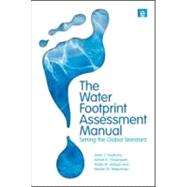
Note: Supplemental materials are not guaranteed with Rental or Used book purchases.
Purchase Benefits
What is included with this book?
| List of Figures, Tables and Boxes | p. ix |
| Acknowledgements | p. xiii |
| Preface | p. xvii |
| Acronyms | p. xix |
| Introduction | p. 1 |
| Background | p. 1 |
| The water footprint concept | p. 2 |
| Water footprint assessment | p. 3 |
| Guide for the reader | p. 5 |
| Goals and Scope of Water Footprint Assessment | p. 7 |
| Goals of water footprint assessment | p. 7 |
| Scope of water footprint accounting | p. 9 |
| Scope of water footprint sustainability assessment | p. 15 |
| Scope of water footprint response formulation | p. 16 |
| Water Footprint Accounting | p. 19 |
| Human appropriation of fresh water: What do we measure and why? | p. 19 |
| Coherence between different sorts of water footprint accounts | p. 21 |
| Water footprint of a process step | p. 23 |
| Blue water footprint | p. 23 |
| Green water footprint | p. 29 |
| Grey water footprint | p. 30 |
| Calculation of the green, blue and grey water footprint of growing a crop or tree | p. 40 |
| Water footprint of a product | p. 46 |
| Definition | p. 46 |
| Schematization of the production system into process steps | p. 47 |
| Calculation of a product water footprint | p. 48 |
| Water footprint of a consumer or group of consumers | p. 52 |
| Definition | p. 52 |
| Calculation | p. 52 |
| Water footprint within a geographically delineated area | p. 53 |
| Definition | p. 53 |
| Calculation | p. 53 |
| National water footprint accounting | p. 54 |
| The national water footprint accounting scheme | p. 54 |
| Calculation of the water footprint within a nation | p. 55 |
| Calculation of the water footprint of national consumption | p. 56 |
| Water savings related to trade | p. 60 |
| National water dependency versus water self-sufficiency | p. 61 |
| Water footprint accounting for catchments and river basins | p. 61 |
| Water footprint accounting for municipalities, provinces or other administrative units | p. 63 |
| Water footprint of a business | p. 63 |
| Definition | p. 63 |
| Choosing the organizational boundaries of the business | p. 65 |
| Calculation of the business water footprint | p. 68 |
| Water Footprint Sustainability Assessment | p. 73 |
| Introduction | p. 73 |
| Geographic sustainability: Sustainability of the water footprint within a catchment or river basin | p. 76 |
| Introduction | p. 76 |
| Environmental sustainability criteria for identifying environmental hotspots | p. 78 |
| Social sustainability criteria for identifying social hotspots | p. 87 |
| Economic sustainability criteria for identifying economic hotspots | p. 88 |
| Assessing primary and secondary impacts in the hotspots identified | p. 88 |
| Sustainability of the water footprint of a process | p. 89 |
| Sustainability of the water footprint of a product | p. 91 |
| Identifying the unsustainable components in the water footprint of a product | p. 91 |
| Water footprint impact indices reflecting local environmental impacts | p. 94 |
| Sustainability of the water footprint of a business | p. 97 |
| Sustainability of the water footprint of a consumer | p. 97 |
| Library of Water Footprint Response Options | p. 99 |
| Shared responsibility | p. 99 |
| Reducing the water footprint of humanity: What is possible? | p. 99 |
| Consumers | p. 103 |
| Companies | p. 106 |
| Farmers | p. 107 |
| Investors | p. 109 |
| Governments | p. 110 |
| Limitations | p. 115 |
| Future Challenges | p. 119 |
| Water footprint assessment methodology and data | p. 119 |
| Application of the water footprint in different contexts | p. 122 |
| Embedding the water footprint in existing water and environmental accounts and reports | p. 123 |
| Linking to ecological, energy and carbon footprint methods | p. 124 |
| Linking to material flow analysis, input-output modelling and life cycle assessment | p. 125 |
| Conclusion | p. 129 |
| Calculation of Green and Blue Evapotranspiration Using the CROPWAT Model | p. 131 |
| Calculating the Process Water Footprint of Growing a Crop: An Example for Sugar Beet in Valladolid (Spain) | p. 135 |
| Calculating the Water Footprint of a Product: Example for Refined Sugar from Valladolid (Spain) | p. 143 |
| Examples of Grey Water Footprint Calculations | p. 147 |
| Environmental Flow Requirements | p. 151 |
| Frequently Asked Questions | p. 155 |
| References | p. 169 |
| List of Symbols | p. 183 |
| Glossary | p. 187 |
| Index | p. 199 |
| Table of Contents provided by Ingram. All Rights Reserved. |
The New copy of this book will include any supplemental materials advertised. Please check the title of the book to determine if it should include any access cards, study guides, lab manuals, CDs, etc.
The Used, Rental and eBook copies of this book are not guaranteed to include any supplemental materials. Typically, only the book itself is included. This is true even if the title states it includes any access cards, study guides, lab manuals, CDs, etc.